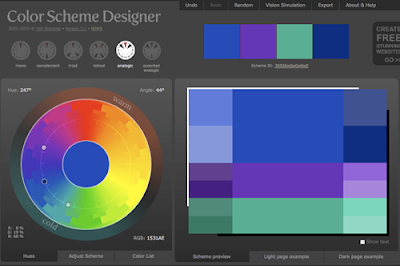 You can dial the scheme around the wheel by placing your cursor onto the floating dark dot. In this way you can see how color relationships change. Here’s a set of cool analogous colors.
You can dial the scheme around the wheel by placing your cursor onto the floating dark dot. In this way you can see how color relationships change. Here’s a set of cool analogous colors. The color swatches on the right are from a complementary scheme playing blues against orange-yellows. The swatches that come out are automatically produced in a variety of values.
The color swatches on the right are from a complementary scheme playing blues against orange-yellows. The swatches that come out are automatically produced in a variety of values. For the designer or decorator, this tool is an interesting way to stimulate new ideas and try things on for size.
Color Scheme Designer
Thanks, Gene






6 comments:
yes that is a great tool.. can i suggest a couple of others? here they are:
http://www.colorschemer.com/online.html
http://kuler.adobe.com
thanks for all the sharing info in your website.. guido
Hi, if you are interested here's a Rembrandt's complete online catalogue whit high resolution paintings!
http://staff.science.uva.nl/~fjseins/RembrandtCatalogue/index.html
have a good day!
your blog is really great! :)
I'm a graphic artist at a public library, responsible for making handfuls of posters every week to advertise different events, ranging from kids stuff (Celebrate Dr. Seuss' Birthday) to seminars for elderly (Ebay made Easy!)
I use Color Scheme Designer all the time, and only once or twice did I go with a scheme that ended up being an eyesore. Its otherwise brilliant with proper evaluation. Using the Light Box/Dark Box options at the bottom right are extremely useful.
The Colorscheme Designer is what I use as well when teaching webdesign classes.
The only problem is that you always end up with color-theory-compliant color scheme.
It can also be interesting to run the Colorscheme Designer, and then change one of the resulting colors for a more 'edgy' color scheme. Your work will be noticed much more easily with a deviating color scheme.
I always say to my students (litteral translation from Dutch to English): if it hurts your eyes, but does not cause pain, you can use it.
Another way to achieve a pleaseant color scheme without using triads, complementary colors, etc, is just looking for a photo that has a pleasant colorscheme. The colorschemes that you find that way, aren't corresponding to color theory in most cases but allow you to find a nice colorscheme without entering the paths that many took before you.
Michael, yes, this system can work for painters, too, especially as a starting point. But as Ivo points out, it IS a mechanical or system-based approach, and sometimes the surprising notes of color that come from outside the gamut give a color scheme the fresh twist that makes it work.
Marco Nelor posted a link to a very interesting online tool today, which uses flickr images. You can select some colors from a box and the tool then shows a series of flickr images that have these colors. Try it, it's amazing!
The tool: http://labs.ideeinc.com/multicolr
Marco Nelor's blog:
http://thurd-eye.blogspot.com/2010/05/multicolr-search-lab-idee-inc.html
Post a Comment